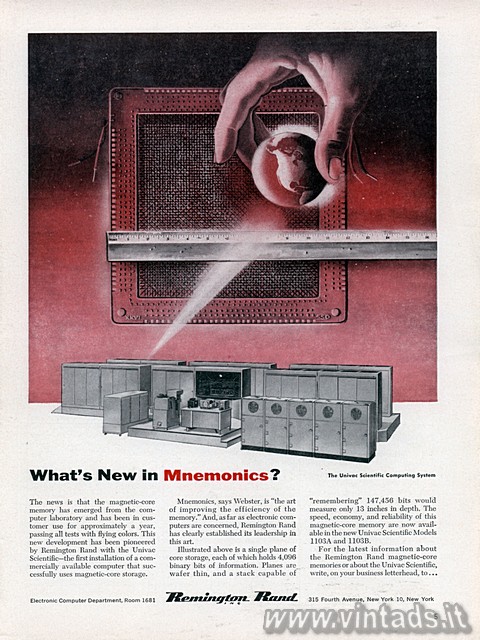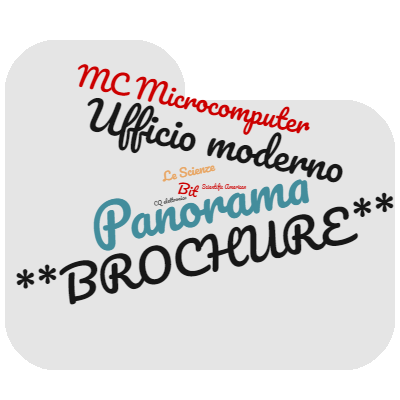What’s New in Mnemonics?

Gradimento: 



 (0 voti)
(0 voti)




 (0 voti)
(0 voti)
Per scaricare questo contenuto devi fare login o registrarti
Commenti: Non è presente alcun commento
Effettua il login per inserire un nuovo commento
Titolo: What’s New in Mnemonics?
Dimensione file: 1,8 MB (2525x3369 pixel)
Tipo del contenuto: pagina di rivista o giornale
Fonte pubblicazione: Scientific American
Data della fonte: June 1955
Linguaggio: en (English)
Marca del contenuto: Remington Rand, Univac

Caricato da: Maverich il 23-05-2020
Testo originale: What’s New in Mnemonics?
The UNIVAC scientific computing system
The news is that the magnetic-core memory has emerged from the computer laboratory and has been in customer use for approximately a year, passing all tests with flying colors. This new development has been pioneered by Remington Rand with the Univac Scientific-the first installation of a commercially available computer that successfully uses magnetic-core storage.
Mnemonics, says Webster, is “the art of improving the efficiency of the memory.” And, as far as electronic computers are concerned, Remington Rand has clearly established its leadership in this art.
Illustrated above is a single plane of core storage, each of which holds 4,096 binary bits of information. Planes are wafer thin, and a stack capable of “remembering” 147,456 bits would measure only 13 inches in depth. The speed, economy, and reliability of this magnetic-core memory are now available in the new Univac Scientific Models 1103A and 1103B.
For the latest information about the Remington Rand magnetic-core memories or about the Univac Scientific, write, on your business letterhead, to…
Remington Rand Inc.
Electronic Computer Department, Room 1681
315 Fourth Avenue, New York 10, New York
Tag:
Dimensione file: 1,8 MB (2525x3369 pixel)
Tipo del contenuto: pagina di rivista o giornale
Fonte pubblicazione: Scientific American
Data della fonte: June 1955
Linguaggio: en (English)
Marca del contenuto: Remington Rand, Univac


Caricato da: Maverich il 23-05-2020
Testo originale: What’s New in Mnemonics?
The UNIVAC scientific computing system
The news is that the magnetic-core memory has emerged from the computer laboratory and has been in customer use for approximately a year, passing all tests with flying colors. This new development has been pioneered by Remington Rand with the Univac Scientific-the first installation of a commercially available computer that successfully uses magnetic-core storage.
Mnemonics, says Webster, is “the art of improving the efficiency of the memory.” And, as far as electronic computers are concerned, Remington Rand has clearly established its leadership in this art.
Illustrated above is a single plane of core storage, each of which holds 4,096 binary bits of information. Planes are wafer thin, and a stack capable of “remembering” 147,456 bits would measure only 13 inches in depth. The speed, economy, and reliability of this magnetic-core memory are now available in the new Univac Scientific Models 1103A and 1103B.
For the latest information about the Remington Rand magnetic-core memories or about the Univac Scientific, write, on your business letterhead, to…
Remington Rand Inc.
Electronic Computer Department, Room 1681
315 Fourth Avenue, New York 10, New York
Tag:
| remington rand univac 1103 memoria a nuclei magnetici |

